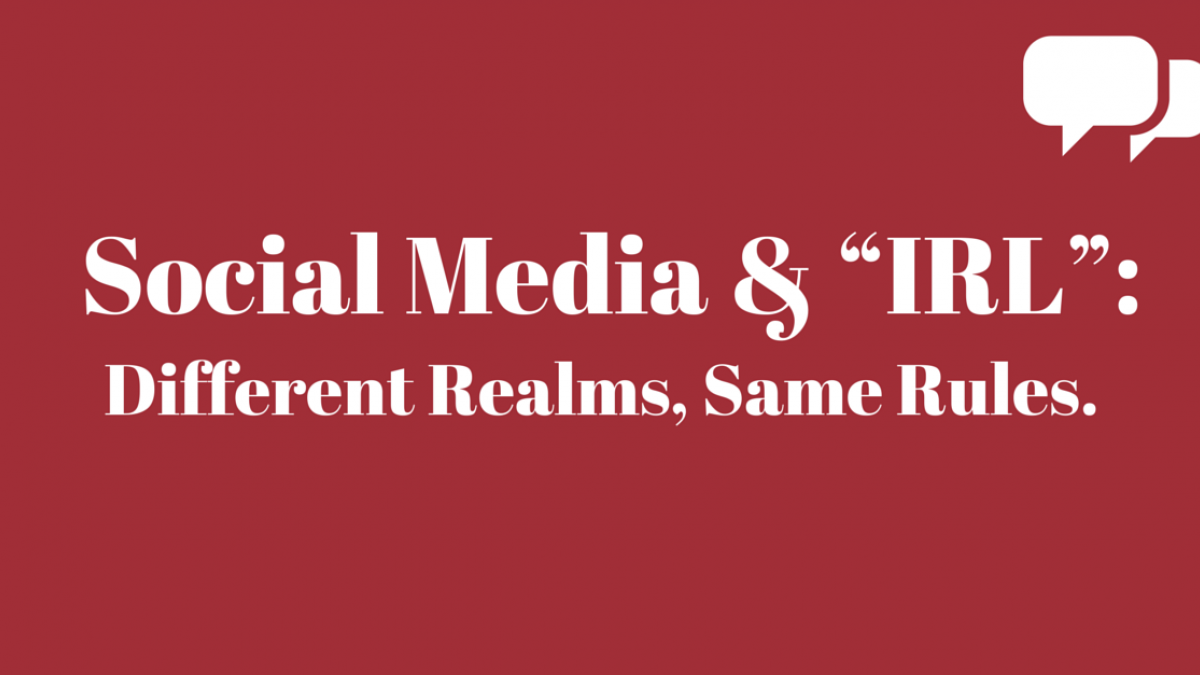
Social Media and “IRL”: Different Realms, Same Rules
Social Media and “IRL”: Different Realms, Same Rules
Has it ever occurred to you that the rise of social media has altered the way we define certain words?
Like “friends?”
Or “like?”
Or even the word “social” itself?
Who would have thought that one day, we’d see someone sitting alone, head down, eyes fixed on a tiny screen, thumbs flying on a tiny keyboard, and understand that he or she was engaged in the act of “being social?” (If you were born after 1980, you’ll have to trust us on this — it’s a leap.)
Yet today, electronic socialization has become so pervasive that we’ve had to come up with a new moniker — “IRL” (short for “in real life”) — to distinguish our non-electronic communications.
Now that social pings, pokes, comments, and likes have become norms across generations — from tweens to great-grandmothers — where exactly does that leave our “IRL?” interactions?
Can we now confidently conduct all our personal and business relations from the comfort of our own swivel chairs, emerging from our Fortresses of Solitude only for the occasional Starbucks run? Will the smartphone never again be used for — umm, what was it we used to call it? Oh, yeah — an actual telephone?
Actually, nothing could be further from the truth.
High Tech or High Touch?
As John Naisbitt noted in his seminal 1999 book High Tech High Touch: Technology and Our Search for Meaning,
Whenever a new technology is introduced into society, there must be a counterbalancing human response — that is, high touch — or the technology is rejected ... We must learn to balance the material wonders of technology with the spiritual demands of our human nature.
Some might say we’ve reached that point in 2015. Ask any salesperson which tactics get the best response rates from his or her prospects these days, and chances are high that the good old phone call or personal drop-in will appear near the top of the list. Remember also that one of the more popular social media sites is Meetup.com, which puts online technology to use in arranging in-person gatherings.
So, what is the key to successful interaction in 2015? Do we need to be brushing up on best practices for LinkedIn … or on our face-to-face networking skills? When we hire, do we need to place more value on candidates’ digital footprints … or on their in-person body language?
Answer: If we’re going to win customers’ hearts and minds in today’s noisy, crowded marketplace, we need to be equally adept at our online and “IRL” interactions.
Now for the good news: They’re really not all that different.
It’s All Social
Whether you’re making a phone call, posting a tweet, or navigating an trade show floor, there’s one common denominator: people. And when you keep that one fact in mind, you’ll start to see how the same interpersonal skills can drive your success in both arenas.
Principle #1: It’s Not About You
Egomaniacs have existed since the dawn of time, and our age is no different. We all know this fellow. Start a conversation about any topic, and within 60 seconds, he’ll turn it around to himself. Visit his Facebook page and you’ll see an endless sea of selfies, facepalm-worthy “hey, who can guess what I’m eating for lunch?” posts, and “see how profound I am” self-quotes.
Brands can be just as bad as — if not worse than — our self-obsessed friend here. You know those guys, too. Every tweet and update is a variation on the “buy our stuff” songbook. Every webinar is a thinly veiled sales pitch. Every e-book is a brochure masquerading as content.
The same truth holds for individuals as for Fortune 500 companies, in person and online: Focus on yourself and you’re doomed to be lonely. Very, very lonely.
Social Graces to Remember
- Follow the 80/20 Rule. Talk about yourself — and that includes sales pitches — no more than 20 percent of the time. Focus the other 80 percent of your interactions on sharing valuable content and fostering genuine conversation.
- Get on the Right Frequency. You’ve heard about the world’s most popular radio station, right? It’s WII-FM: What’s In It For Me? When asking people to sign up for your e-newsletter, follow you on social media, or set up a face-to-face meeting, give them a compelling reason to do so. And no, “keep up with what’s going on in our company” and “learn more about our products” are not compelling reasons.
Principle #2: It Is About Listening
Mark Twain once wrote, “If we were meant to talk more than listen, we would have two mouths and one ear.”
Let’s face it: listening is rare these days. Business types — especially marketers — spend years learning how to get their message across. But how much time and effort do we focus on the lost communication skill of listening?
In an environment where everyone’s trying to shout over one another to make themselves heard — both online and IRL — there is tremendous power in lending an attentive ear. Not only can you learn a lot, but once current and prospective customers know you really are listening to them, they’ll support you for life.
Social Graces to Remember
- Listen Before You Speak. Master networkers will tell you that any time you join in a conversation, it’s wise to wait at least 5 seconds before speaking so that you can get a feel for what’s being said. The same is true for online interactions. Make sure your social media strategy includes some time spent “out there” every day, quietly listening to what your current and prospective clients are saying. You’ll learn a lot.
- Respond Appropriately … and Genuinely. When someone in your social network announces good news, like a big new account or the opening of a new location, do what you would do in real life: congratulate them. Likewise, if the news is not so good, a word of sympathy or encouragement can go a long way.
Principle #3: Give First
In his best-selling 2013 book Give and Take: Why Helping Others Drives Our Success, Wharton School of Business professor Adam Grant presented the results of an extensive research project that tracked the success rates of people in three categories: takers, matchers, and givers.
So, which group had the highest success rate? The givers — that “rare breed of people who contribute to others without expecting anything in return.”
We marketers can learn something from Grant’s research, both online and IRL. The old Mad Men model of marketing and selling — “give us your money first, then we’ll give you something of value” — has gone the way of the dinosaur. In today’s hyper-competitive market, where the consumer holds all the power, brands that give first are the brands that win.
Social Graces to Remember
- Look for Opportunities to Be Useful. Hilton Hotels has created a Twitter account, @HiltonSuggests, dedicated to helping people who are exploring a new city and looking for tips. No selling, no hype, just help. How could you leverage this approach for your brand?
- It’s the Little Things That Count. Being a “giver” doesn’t have to involve huge, expensive purchases or elaborate programs. It could be a personalized word of advice on how to handle a problem. It could be an unsolicited word of praise on social media. It could be a phone call just to ask (genuinely, please), “How's it going?”
Connecting Two Worlds
Online and “IRL” interactions can both be effective methods of building relationships on their own. Leveraged together, they can be a force of nature.
Social makes IRL interactions “sticky.” In-real-life encounters — from a trade show attendee stopping by your booth to a chance encounter at a networking event — are by definition fleeting. Eventually you need to part ways. Wrapping up those personal encounters with a connection on social media opens up real possibilities for regular touch points that can foster a long-term relationship.
IRL makes social interactions personal. Of course, business isn’t built on Twitter followers and Facebook fans — it’s built on personal relationships. With the right system, you can track those social contacts’ interactions and take certain conversations to a more personal level. For example, if a specific contact frequently likes your posts and comments on your blog, that’s your cue to reach out for a personal phone call to take the relationship to a deeper level. (Yes, this is where having a solid, integrated content management and marketing solution is key.)
As marketers, we work in an environment that is rife with unprecedented opportunities … and fraught with unprecedented challenges. Technology has made people more connected than ever before, and yet our high-tech lives have left us craving more high-touch interactions. By leveraging the power of both online and “in real life” communications — and keeping our focus on building relationships rather than chasing revenue — we can build a community of loyal, engaged followers, many of whom will become customers for life.

